Isn't amazing how the culture of the (physical Yoga) Hatha Yoga evolved mostly among women? Are we men ashamed to practice this body-mind-spirit wisdom because it became a women’s thing, or discriminative of the idea that we men are tough enough and don’t need this kind of “activity”? We know that the practice of Hatha Yoga was brought to our western culture in the 20th century by masculine Yoga masters, and that mostly men are the creators of the original Yoga Sutra of Patanjali approx. 200 B.C.E - 200 C.E., known also as Raja Yoga or King’s Yoga – the basis of all other Yoga forms practiced around the world.((Internet Encyclopedia of Philosophy:
The Yoga Sutras of Patanjali)) Keep in mind that Yoga goes much deeper than the physical posture and breathing, yet they are the start and the basis for the inward journey of self-inquiry and self-discovery. The deeper you immerse in the practice, the more you’ll happen to find out about it. An Asana -
aasana((Wikipedia:
Asana)) or
Yoga posture is practiced with a purpose to mobilize the body and mind for achieving mental skills. This tells us that Yoga indeed is great for men. Not long ago, when I invited a friend of mine to a Yoga Asana session I was teaching, he looked at me discouraged with a shy smile on his face, saying “Really, Yoga for men? I don’t know about that. Me, with this belly, tense as I am, it would be an embarrassment to show myself in front of the other more flexible people, let alone perform postures.” I smiled back, and with encouraging voice told him "You always talk about getting in shape! Just come over please and see how simple yoga exercises can change the way you feel about yourself!" With the 7 exercises that follow, in just an hour, we succeeded to remove his misconceptions he had about yoga for men, and changed his
atti
tude positively. Although he was never fond of practicing in groups, he got hooked up - he liked all the beginner postures and started practicing at home regularly and diligently. The most important and ideal Yoga posture are:
“sthirasukhamaasanam” – steady and comfortable posture.
Sthira meaning steady, stable and strong and
sukham meaning comfortable, easy and peaceful, and
aasana meaning body posture or pose. This is the entire instruction from the whole Yoga Sutra (YS, 2.46-2.48) on how a Yoga posture ought to be performed. As long as you apply the elements of stability and comfort to your body posture and align it with your breath (YS, 2.47), you perform the
aasana correctly. Every man who wants to gain control over his physical and mental well-being and achieve a healthier lifestyle has the reason to get into Yoga. And here is the deal, in the next seven Yoga exercises you’ll see how to get into Yoga safely and successfully. Get ready and get healthier now!
1. Tadaasana – The Mountain Pose (Variation A - Ideal Alignment)
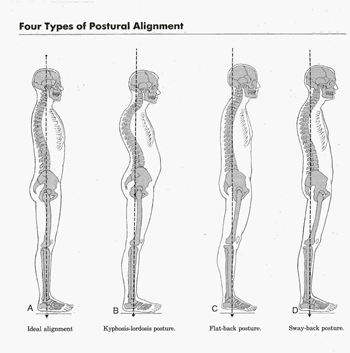
- Stand up on your feet (see type A), preferably bare feet so you can connect to the ground. Breathe deeply and slowly.
- Feet aligned with the hips.
- Kneecaps and thigh muscles slightly contracted.
- Pelvis leveled horizontally.
- Chest open.
- Shoulder blades relaxed.
- Connect the tip of the thumb with the tip of the index finger - energy re-circulation.
- Face muscles relaxed (eyes slightly closed, mouth slightly open).
- Breathe gently in this position.
- On inhalation, your head is pulling (cranially) upwards, lengthening the spine.
- Create a virtual thread inside your body from the heels up to the crown - tip of your head.
- Breathe gently, make sure your whole body is aligned as instructed.
- Connect to the thread and notice its movement.
- Stay in this position for 12 breaths – 4 sec. inhale and 6 sec. exhale - approx. 2 minutes according to the deep breathing exercise no. 1 in my previous post.
When practicing physical Yoga, we are counting breaths instead measuring time. Aligning the breath with the body posture is an element for the connection with your inner clock – a closer look on what’s going on inside you – inner awareness. The goal of the Mountain Pose is:
- Stabilizing the nervous system through breathing.
- Building energy and releasing tension.
- Stabilizing the movement of the thread (inner stability) through the help of breathing.
- Developing inner awareness.
- Awareness of inner movement of body’s stability (the strength) and comfort (the easiness and lightness).
- Creating a rhythmical breathing.
- Improving focus, concentration and observation.
2. Virabhadraasana – The Warrior Pose (Variation)
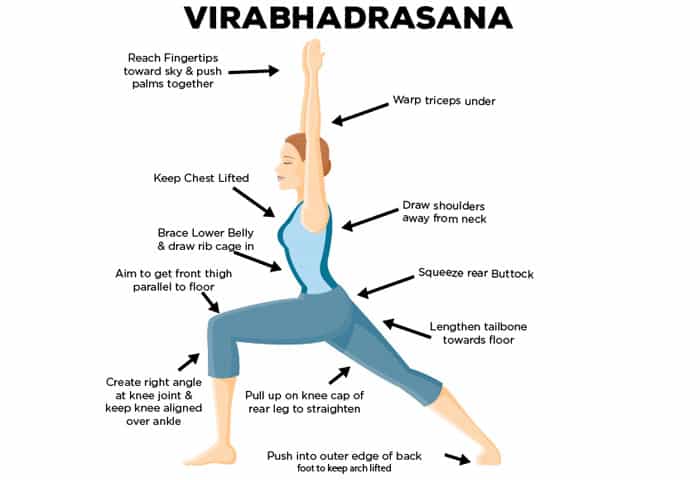
- From Mountain pose exhale gently make a step forward (approx. 3 feet) with your right foot (see picture above) and slowly bend you right knee so your pelvis sinks (only as far as it is comfortable) towards the floor. Tip: Place left knee on the mat or a pillow if your muscles can’t support this posture.
- Make sure your body weight is balanced 50/50 on both legs.
- Inhale gently, reach fingertips towards the sky - push palms together, chest is open, shoulder blades relaxed – go down.
- Breathe consciously, deeply and rhythmically (abdomens relaxed). Be aware of the expansion of your groin area as you inhale.
- Focus your gaze on one point and remain in this position for five slow, deep breaths (or for as many as it feels right for you).
- Concentrate completely on the contractions of your thigh muscles and the pressure on your hip joints. Balance your weight 50/50 on both feet.
- Build energy with each inhalation!
- Release tension with each exhalation!
- Don’t let the muscle contraction intensify too much and disturb your breathing rhythm. Float the pelvis up and down to balance the intensity of the muscle contraction.
- Do the same with your arms. The moment you feel that the muscle contraction of your shoulders disturb you breathing, spread and lower the arms.
- Exhaling, make a step back, lower your arms and come back to Mountain pose.
- Have a break with one long, deep breath.
- Repeat the same (step 1 to 11) with the left foot.
Make three rounds (3 x right foot, 3x left foot). The goal of the Warrior Pose is:
- Building energy and releasing tension.
- Stretching and strengthening thigh and gluteus muscles.
- Stretching hips (groin muscles) and mobilizing hip joints.
- Strengthening back muscles.
3. Trikonaasana – The Triangle Pose (Variation)
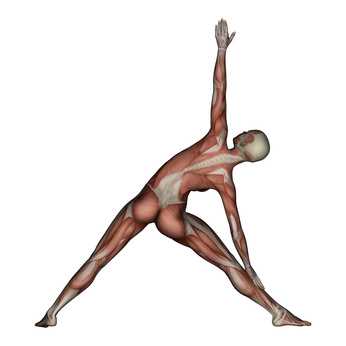
- From Mountain pose, spread your feet approx. 2-3 feet laterally. Left foot 0°, right foot 90° to the right (adjust the degree of your feet as you see fit. Tip: For better alignment and results do this pose against a wall and adjust your posture with the hands).
- Inhale gently, spread your arms at the height of your shoulders (palms facing forward).
- Further slow, deep inhalation lengthens the spine upwards.
- Slowly exhale and from the lowest vertebra begin to bend to the right (vertebra for vertebra, from the lowest upwards). The left hip goes lightly to the outside. Slowly! When bending you must feel firm and comfortable. Your right palm lays on your right kneecap (or lower, if you are more flexible). Your left hand stretches up vertically following the bending of your spine.
- Focus your gaze on one point and remain in this position for five slow, deep breaths (or for as many as it feels right for you). Feel the flexibility of your spine and any tensions in the back, legs or pelvic area.
- With each inhalation build up energy and with each exhalation release tension. Slowly adjust your pelvis, torso, neck, etc. if necessary during your rhythmical breathing.
- With an exhalation, slowly, come back into position no. 3.
- Have a break with one long, deep breath.
- Repeat the same (step 1 to 8) going to the left.
Make three rounds (left and right). The goal of the Triangle Pose is:
- Building energy and releasing tension.
- Mobilization of spine, pelvis area and groin muscles.
- Mobilization of lower back (lumbar spine) and shoulders.
- Strengthening superficial and core back muscles.
4. Malasana – The Squat Pose
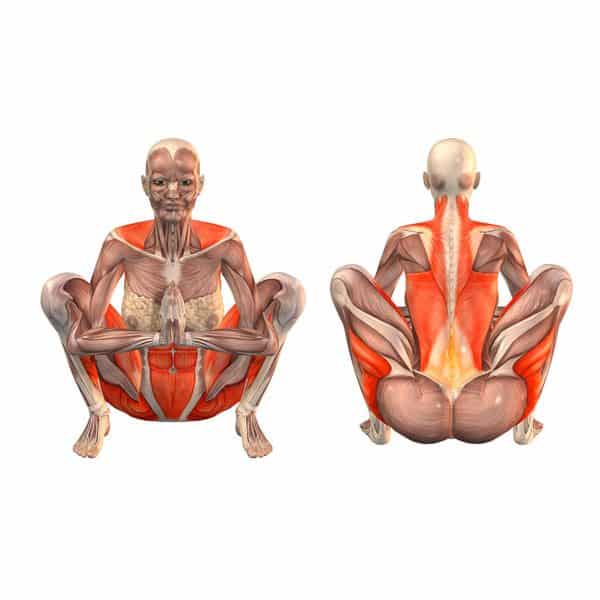
- From Triangle pose come into Mountain pose and for a five deep gentle breaths, rotate the pelvis (in both sides) to align your muscles, tendons and ligaments.
- Spread your feet approx. 2-3 feet laterally, open both feet approx. 45° outwards.
- Inhale gently extending the whole body upwards, palms together pushed to the chest.
- Exhale gently, go into squat lowering your pelvis – keep your back straight as you go down. Your upper body leans slightly forward and your elbows touch the inner side of your knees. Tip: Lower slowly only as much as you feel comfortable. If you have to inhale on your way down, just do it only to be able to exhale lowering further. The goal is to squat so your buttocks touch your heels, but you go only as much as your posture feels steady and comfortable.
- Find your optimal position and stay there for five gentle breaths (or for as many as it feels right for you). Chest remains open at all times, push your elbows gently against your knees so you stretch the groin muscles.
- Do gentle moves in this posture so you align your hips, thigh muscles and lower back optimally.
- Use your thigh muscles to come up to Mountain Pose, but only after you have exhaled 50% of your air volume (don’t stand up while your lungs are under pressure full of air).
Repeat this five times (adjust repetition as you see fit, if you feel comfortable and energetic do more than five, if not, do less). The goal of the Squat Pose is:
- Building energy and releasing tension.
- More flexibility in groin muscles.
- Stretching and strengthening lower back muscles.
- Mobilization of hip joints.
- Strengthening thigh muscles and knees.
5. Bhujangasana – The Cobra Pose (Variation)
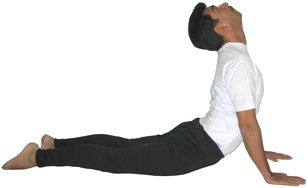
- From Mountain Pose exhale gently and lower down to Squat Pose, place your palms and knees on the floor and gently stretch your body onto the floor. Your forehead touches the floor, your palms are placed right next to your chest - below your shoulders.
- Relax your whole body, have a gentle deep breath, feel the connection of your whole body with the floor. Put a light pressure on your palms, as preparing for a push-up.
- Inhaling gently, slowly lift up your head and neck and feel the pressure 50/50 on your hands and pelvis area.
- Using the strength of your arms come up vertebra for vertebra beginning from the lowest one. The upper back, neck and head are straight, chin muscles relaxed, mouth slightly open. As you’re half way through, inhale further to open up the chest maximally and erect your upper body (only as much as possible). Remember, the posture must be firm and comfortable.
- Exhale through your mouth and let the weight of your upper body hang on your shoulders. There should be light pressure on the lower back. Adjust the position of your hands on the floor so your shoulders support the weight of your upper body optimally.
- Take five slow deep breaths in this position and feel the pressure (or relieve) on different parts of your body.
- Experiment - adjust the position of your torso moving it, especially paying attention to your lower back.
Repeat five times. The goal of the Cobra Pose is:
- Building energy and releasing tension.
- Mobilizing each spine vertebra.
- Strengthening arm, shoulder and back muscles.
- Stretching groin muscles.
6. Chaturanga Dandaasana - The Four-Limbed Staff Pose (Variation)
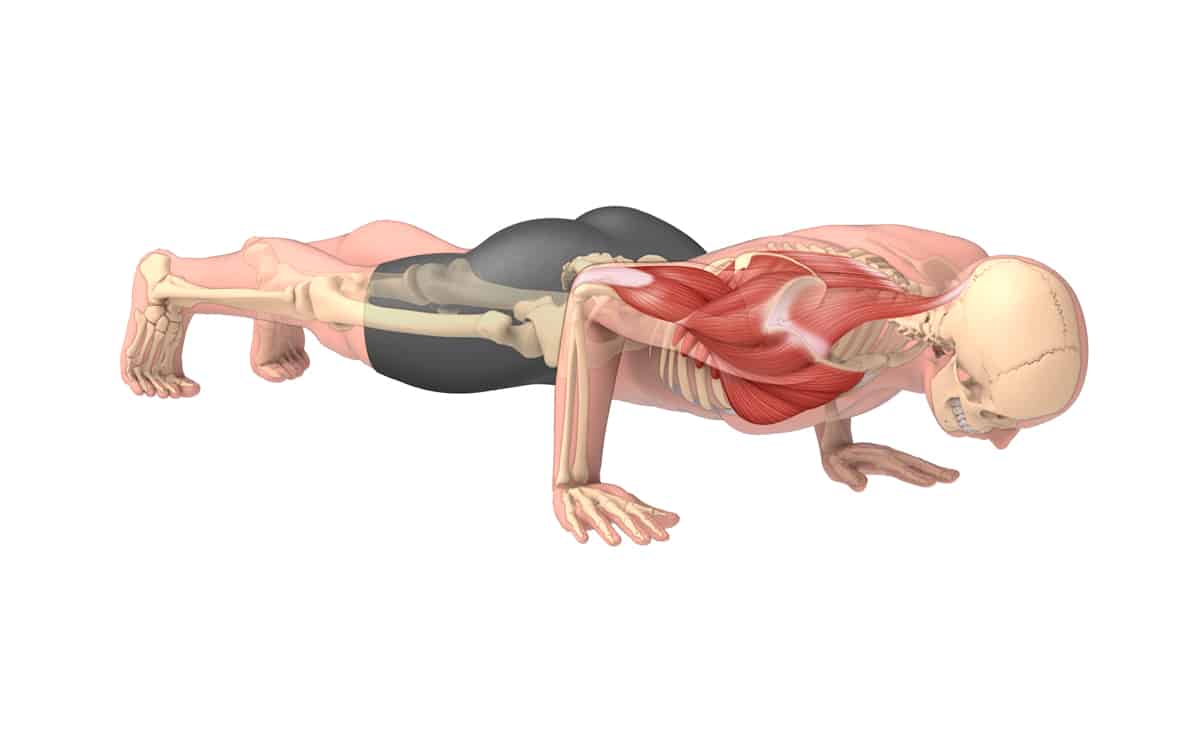
- From the cobra pose - body and forehead on the floor, inhale deeply - put your palms close to the chest, put your toes on the floor, preparing for push-up.
- Exhale, lift up your head, tighten your abdomen muscles, use the strength of your arms and lift up your body just a few inches.
- You are in four-limbed staff pose, take five gentle, deep breaths (adjust body height accordingly, if necessary put your knees on the floor as support).
- Exhale, come back to the floor - relax the whole body placing the forehead on the floor.
Repeat this exercise three times. The goal of the four-limbed staff pose is:
- Building energy and releasing tension.
- Stabilizing all muscles involved.
- Strengthening back muscles, anterior shoulder muscles, chest and arm muscles.
- Strengthening thigh and gluteus muscles.
7. Phalakaasana – The Plank Pose (Variation)
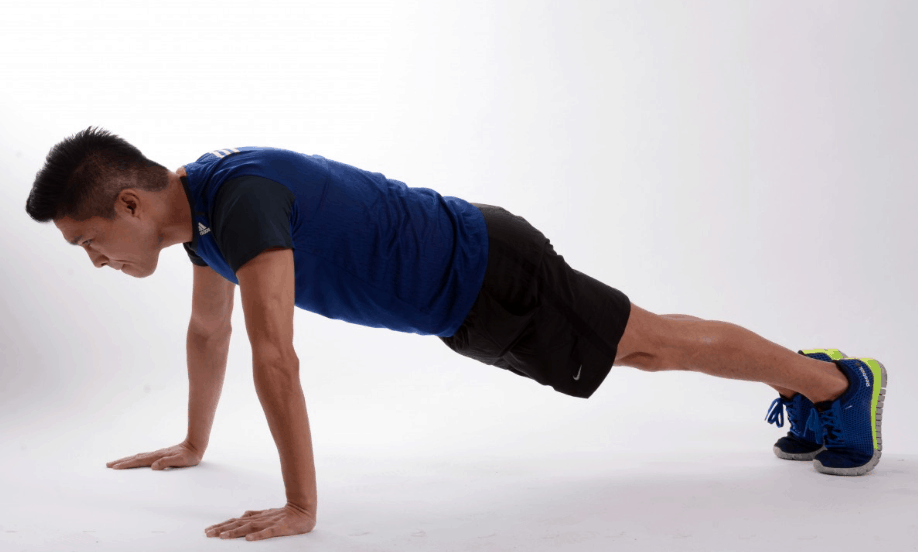
- From your relaxed position on the floor, inhale deeply, place your palms close to the chest, lift up your head, put your toes on the floor, preparing for push-up.
- Exhale through your teeth, tighten your abdomen muscles, use the strength of your arms, and push-up your body to come into a plank pose.
- Adjust your palms or feet to find the ideal position and stay in for five slow deep breaths. Tip: To mobilize (strengthen and flex) your body, do variations of this exercise by slowly lowering the pelvis (when exhaling) - the knees touch the floor and balance the pressure between the arms and knees.
- Exhale, come down to the floor and relax your body. Inhale - feel the energy coming in, exhale - feel the tension leaving your body.
Repeat this exercise three times. The goal of the plank pose is:
- Building energy and releasing tension.
- Strengthening chest, arm, and shoulder muscles.
- Strengthening overall back muscles and lumbar spine area.
- Strengthening thigh and cough muscles.
- Building endurance and flexibility.
Your Yoga Session is finished. Spend a moment lying on the floor
breathing gently and deeply, and store all the movements and experiences you have undergone in this practice. Now having more strength and vitality, take this experience and apply it constructively in your daily life. Know that you will come a step further in your next practice and experience a new insight.
Final Thoughts
The practice of these Yoga exercises should take some 45-50 minutes, however you can change the repetitions and number of breaths according to your physical and mental fitness. Looking at all these simple yet highly beneficial postures, we can conclude that apart from the physiological benefits as mobilizing and strengthening the body, more important benefits out of these exercises are:
- The development of mental skills such as focus, motivation, observation, confidence, concentration by turning inwards through the focus on gentle breathing.
- The regaining of vitality and building of stamina and resilience through the repetition of movement.
- The reduction of stress and neuroticism ((NCBI: Neuroticism)) as a result of the above two.
The benefits mentioned above are perceptible when a balanced flow between breath and body movement is created. Yoga can take you to a new beginning for a prosperous change that sets new goals with great motive for improvement. Let these 7 Yoga Exercises be your goal.
Make a routine (in your own rhythm - harmonically) by practicing these exercises every single day. You will see positive physical and mental changes in a matter of weeks. And if you choose to be a part of a yoga class don’t worry about how you look, and what you’re going to wear as long as your clothes are comfortable. Stay focused on what you want to achieve on a physical, mental and spiritual level.
Keep in mind that everything you need for that new change in your life is sitting right here within you. Start to practice and the process of achievement will unfold! I salute the spirit in you!
More About Yoga








No comments:
Post a Comment